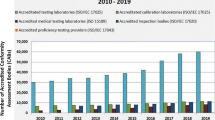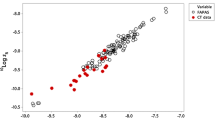Abstract
Proficiency testing is an external quality control check, whereby the quality of an analytical result is checked against criteria that are set independently of the laboratory carrying out the analysis. Participants in a proficiency test are encouraged to use the method of their choice to determine the analyte in question. The collated results submitted by the participants are used to derive the best estimate of the ‘true’ level, or assigned value, of the analyte, as a consensus value of the whole data set. Generally, the data submitted will be normally distributed and from a single population, but if a data set is found to be multimodal, then the selection of one of the modes as the assigned value is possible where there is supporting data, typically methodology information. Unless there are independent grounds for preferring one mode over another, it is not possible to set an assigned value or calculate z-scores. However, the analysis of allergens has presented proficiency testers with a new challenge, since it has become apparent that quantitative results may be dependent on the brand of enzyme-linked immunosorbent assay kit used, the specific analyte targeted (e.g. total content or allergen protein content) and the limit of detection achievable. FAPAS® has run more than 40 proficiency tests for allergen analysis over the past 7 years, during which time methods have been developed and improved and the requirements for determination of food ingredient allergens has increased. Two case studies are presented which highlight some of the issues around the use of allergen measurement methods.

A selection of food items which might cause allergenic or intolerance reactions





Similar content being viewed by others
References
Tariq SM, Stevens M, Matthews SM, Ridout S, Twiselton R, Hide DW (1996) Br Med J 313:514–517
Hourihane JO’B, Kilburn SA, Nordlee JA, Hefle SL, Taylor SL, Warner JO (2007) J Allergy Clin Immunol 119:1197–1202
Request No. EFSA-Q-2003-016: Opinion of the Scientific Panel on Dietetic Products, Nutrition and Allergies on a request from the Commission relating to the evaluation of allergenic foods for labelling purposes (adopted on 19 February 2004), http://www.efsa.eu.int/science/nda/nda_opinions/catindex_en.html
Thompson M, Ellison S, Wood R (2006) Pure Appl Chem 78(1):145–296
ISO/IEC 17025:2005. General requirements for the competence of testing and calibration laboratories
Regulation EC 882/2004, Official Journal L 165:0001-0141
Fearn T, Thompson M (2001) Analyst 126:1414–1417
Analytical Methods Committee (1989) 114:1693–1697
Lowthian PJ, Thompson M (2002) Analyst 114:1359–1364
Thompson M (2000) Analyst 125:385–386
FAPAS® 2002 Protocol for the organisation and analysis of data, 6th edn.
Poms RE, Klein CL, Anklam E (2004) Food Addit Contam 21(1):1–31
Poms RE, Anklam E (2004) GIT Lab J Eur 1:43–46
FAPAS® Allergens Report 2745, October 2008
FAPAS® Allergens Report 2727, November 2006
Author information
Authors and Affiliations
Corresponding author
Rights and permissions
About this article
Cite this article
Owen, L., Gilbert, J. Proficiency testing for quality assurance of allergens methods. Anal Bioanal Chem 395, 147–153 (2009). https://doi.org/10.1007/s00216-009-2739-3
Received:
Revised:
Accepted:
Published:
Issue Date:
DOI: https://doi.org/10.1007/s00216-009-2739-3




